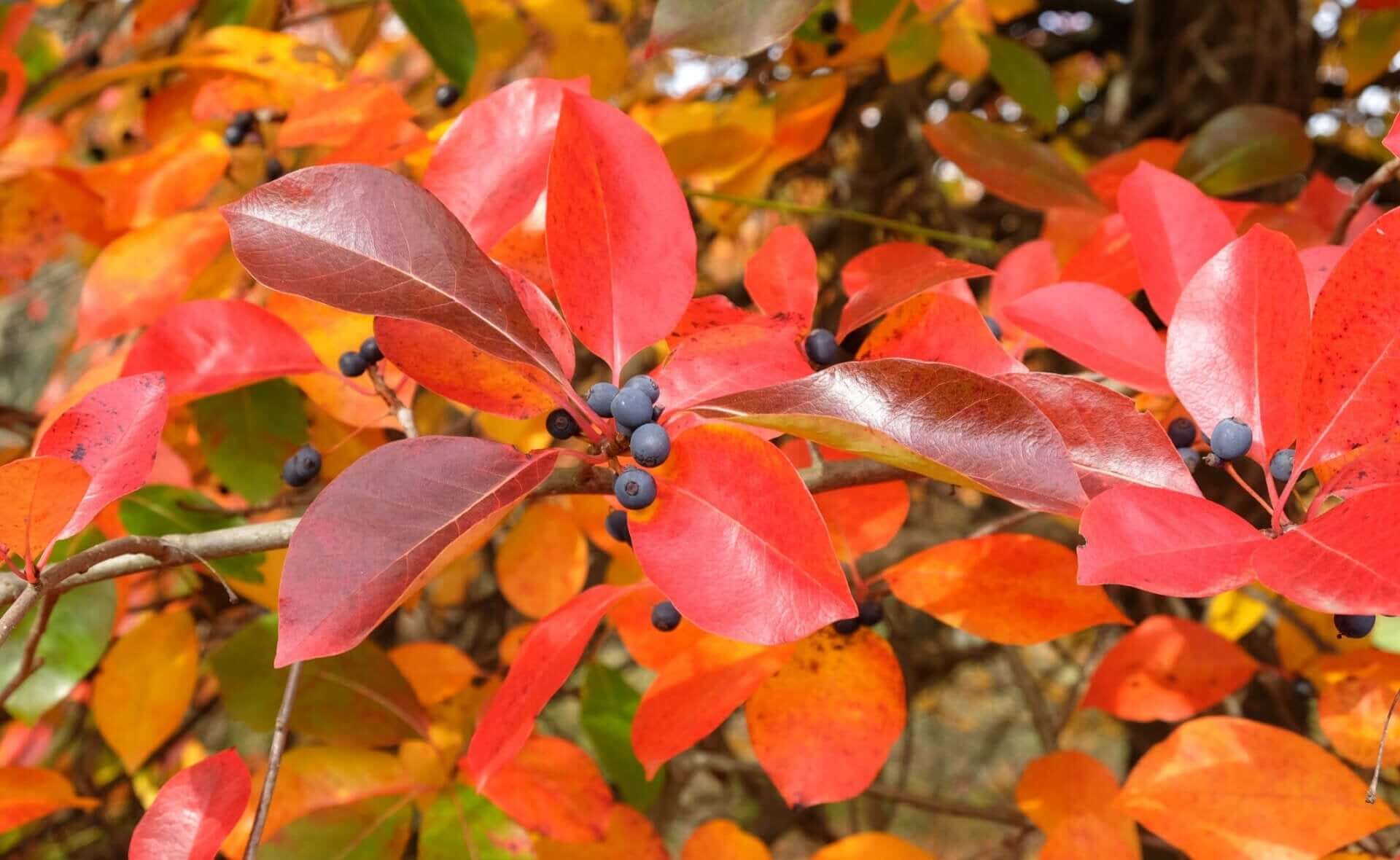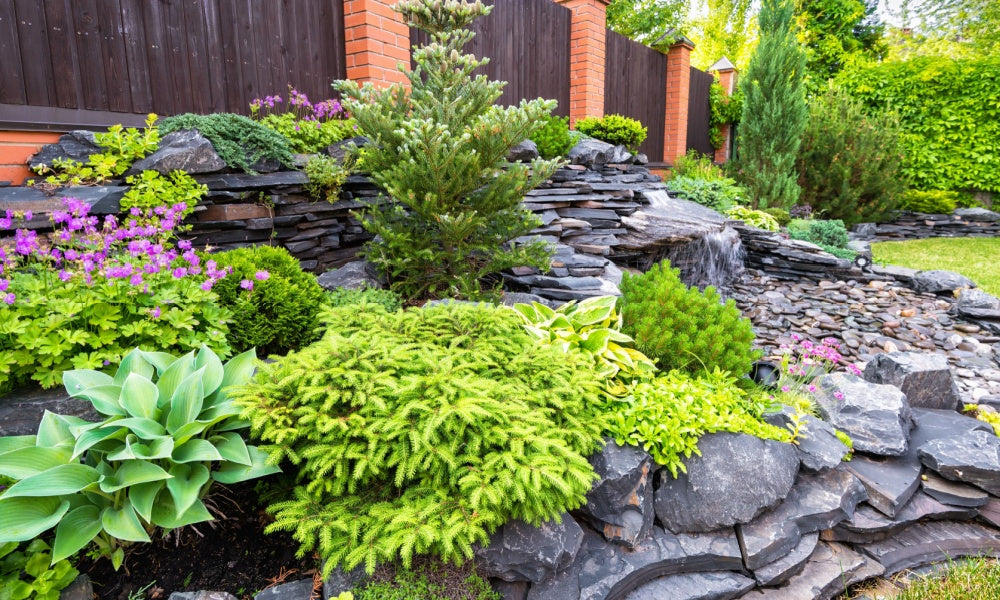Four colorful shrubs to build a shrub-based garden, maximizing both color and structure throughout the seasons:
- Red Weigela – Vibrant red flowers are great for attracting hummingbirds.
- Blue Hydrangea – Beautiful large blooms; color depends on soil pH.
- Red Raspberry Bush – Edible berries - spread quickly if not managed.
- Cistena Plum (Purple Leaf Sand Cherry) – Ornamental shrub/tree with deep purple foliage
Red Weigela (Weigela florida 'Red')
The Red Weigela attracts gardeners with its vibrant red trumpet-shaped blooms and gracefully arching branches. This honeysuckle family member bursts into color during late spring and maintains its vibrancy through the summer with smaller blooming periods.
The vivid red flowers stand out dramatically against lush green leaves, creating eye-catching displays in garden borders and foundation plantings and serving as a striking hedge.
Plant Type: Deciduous shrub
Family: Caprifoliaceae (Honeysuckle family)
Native Range: Asia
Mature Size: 4–6 feet tall and wide
Sun Exposure: Full sun to partial shade
Soil Preference: Well-drained, slightly acidic to neutral soils
Bloom Time: Late spring to early summer
Flower Color: Bright red
Attracts: Hummingbirds, butterflies, pollinators
Red Weigela originates from Asia yet has become popular in North American gardens because of its decorative appeal and low maintenance needs. The shrub grows between 4 and 6 feet, forming rounded shapes with arching branches that create a soft, natural look.
Wildlife and Ecology:
Hummingbirds often visit this plant because they find the tubular red flowers attractive for nectar feeding. Red Weigela blossoms draw butterflies and additional pollinators and are essential for pollinator gardens.
Growing Conditions:
Full sun exposure leads to the best flowering results for Red Weigela, which remains viable when planted in partial shade.
It grows best in moderately fertile soils with good drainage but can adapt to various soil types, provided they allow adequate drainage. After establishment, the plant showed moderate drought resistance and needed little maintenance. After blooms fade, gardeners should prune their plants to shape them appropriately and promote future flowering.
Garden Uses:
Red Weigela is a vibrant specimen plant or an excellent colorful shrub border.
The Red Weigela thrives in cottage gardens, mixed beds, and wildlife gardens, but it is also suitable for container planting in patios or small urban yards. This plant achieves visual attractiveness through its vibrant flowers and small size and needs minimal upkeep.
Noteworthy Characteristics:
- Non-invasive and low-maintenance
- Resistant to deer and rabbits
- Reblooming potential with light summer pruning
Gardeners seeking durable color combined with hummingbird-friendly aesthetics will find Red Weigela an ideal compact shrub option.
Blue Hydrangea (Hydrangea macrophylla)
Blue Hydrangeas are an exceptional flowering shrub because of their gorgeous flowers and adaptability to different garden environments! The plant stands out with its large, globe-shaped flower clusters, making it an ideal selection for bringing vibrant color to semi-shady garden spots.
Blue Hydrangeas bloom starting mid-summer and continue until the fall, a long stretch of colorful display.
Growing Conditions:
Ideal growing conditions include moist yet well-drained soil and placement in areas that receive partial or complete shade. Soil pH levels determine the color of the flowers. Blue flowers emerge from acidic soils, whereas alkaline soils produce blooms with pink or purple hues. The ability of the blooms to change color according to soil pH lets you customize your garden's appearance. Blue Hydrangea needs regular watering to keep its growth healthy because it requires consistent moisture throughout hot weather.
Size and Growth Habit:
Blue Hydrangea reaches a height between 3 and 6 feet while extending to a matching width. The Blue Hydrangea's compact, rounded shape works well in small gardens and expansive landscapes. The broad, deep green leaves create a lush backdrop to the blooms but transform into yellow foliage in the fall, which maintains seasonal interest after the flowers have faded.
Flowering and Appeal:
Blue Hydrangea's abundant and showy flower clusters serve as its primary draw. Blue Hydrangea blooms make excellent additions to cut flower arrangements because they maintain their size and durability well. Garden landscapes become more appealing with the striking blue flowers that serve as a focal point and work well in mass plantings and mixed border designs.
Maintenance:
Blue Hydrangea is low-maintenance once established. To preserve next year's blossoms, gardeners should prune Blue Hydrangea after it finishes flowering. Applying mulch at the base will keep the soil moist and safeguard roots from cold weather damage. Both bees and butterflies find this shrub an excellent attraction source.
Blue Hydrangea is a beautiful, flexible shrub that adds vibrant color while requiring minimal maintenance.
Red Raspberry Bush (Rubus Idaeus)
The Red Raspberry Bush is a deciduous shrub with multiple stems that bears sweet ruby-red berries while displaying upright arching canes. Its preference is full sun and well-drained fertile soil, and it is an outstanding choice for edible landscapes, pollinator gardens, and backyard orchards.
The Red Raspberry Bush reaches heights from 3 to 6 feet and spreads its growth through suckers which eventually develop into fruitful thickets. The compound leaves of this plant display bright green surfaces with serrated margins and undersides covered in soft hairs.
During late spring, small clusters of delicate white flowers emerge, attracting bees and other beneficial pollinating insects. During mid to late summer, the plant matures its prized produce, which consists of juicy red raspberries with a balanced tart-sweet flavor ideal for fresh consumption, baking recipes, and preservation.
Plant Type: Deciduous fruiting shrub
Height: 3-6 feet
Spread: 3-5 feet
Sunlight: Full sun to light shade
Soil: Rich, well-drained, slightly acidic
Bloom Time: Late spring
Fruit Ripens: Mid to late summer
USDA Zones: 3–8
Wildlife Value: High – attracts pollinators and wildlife
Raspberries are typically biennial in their cane structure: Primocanes mature in their first year through vegetative growth, while floricanes bear fruit in their second year before dying. Annual pruning becomes essential for sustaining productivity because of the plant's unique growth cycle. The bush produces fruit naturally without requiring cross-pollination because it is self-fertile.
The Red Raspberry Bushes yield optimal results in USDA planting zones 3 through 8 because they handle cold winter conditions and moderate summer temperatures.
The plants require full sun exposure but can manage growth in light shade conditions. Applying mulch around the base preserves moisture levels. It prevents weed growth while maintaining 2 to 3-foot spacing between plants, which allows for adequate airflow and minimizes fungal diseases such as cane blight and powdery mildew. See Martha Stewart's care guide for Raspberry Bushes.
This plant has high wildlife value. Birds and mammals eat the fruit, which grows in dense thickets that protect smaller animals. Home gardeners, along with culinary experts, both highly value the fruit when it is grown.
Red Raspberry Bush plants deliver beautiful seasonal displays and valuable ecological features while supplying tasty fruit yields yearly for fruit hedges and berry patches.
Cistena Plum (Prunus x Cistena)
The Cistena Plum, or Purple Leaf Sand Cherry, is a compact deciduous shrub or small ornamental tree admired for its striking reddish-purple foliage and delicate pink blooms.
Cistena Plum typically grows to 6 to 10 feet in height, with a spread of 5 to 8 feet. It grows in a rounded or vase-like shape, often becoming denser with light pruning. Its deep purple leaves hold their rich color throughout the entire growing season, making it a standout among green-foliaged companions.
In early to mid-spring, before the leaves fully emerge, the Cistena Plum produces single, fragrant, pale pink flowers along its branches. Bees, butterflies, and other pollinators find these blossoms attractive; Small, reddish-purple fruits follow blossoms in summer. Though the fruit is edible, it is ornamental primarily and may attract birds and small mammals.
Special Features:
Plant Type: Deciduous shrub or small tree
Height: 6–10 feet
Spread: 5–8 feet
Sunlight: Full sun to partial shade
Soil Type: Well-drained; adaptable
Bloom Time: Early to mid-spring
Flower Color: Pale pink
Wildlife: Attracts pollinators and birds
Hardiness Zones: 2–8
Cistena Plum prefers full sun to partial shade and well-drained soils. It tolerates various soil types, including clay, loam, and sandy soils, and can adapt to urban conditions. Once established, Cistena Plum is moderately drought-tolerant, but would benefit from regular watering during prolonged dry spells.
Often used as a specimen plant, informal hedge, or foundation accent, it brings vibrant foliage and seasonal color to borders, gardens, and small urban spaces. It is hardy in USDA Zones 2 to 8 and can be pruned to maintain a more tree-like form if desired.
While relatively low maintenance, it may be susceptible to common cherry tree issues such as leaf spot, powdery mildew, or borer insects, so proper placement and care are key to long-term health.
With its compact form, showy leaves, and early spring flowers, the Cistena Plum adds year-round interest and visual appeal to residential landscapes, particularly where a pop of bold foliage is desired.
Shrub Benefits Summary:
Shrubs add height, form, and texture to a garden, creating layers and visual interest.
Many shrubs offer colorful flowers in spring/summer and vibrant foliage in fall.
They help define boundaries and pathways in a landscape and can act as natural screens or wind barriers.
When designing, use taller shrubs in the back and colorful and edible ones in the front.
The Blossoms and Bulbs staff will be happy to advise you on shrub selection. Contact us for expert advice.
Read more

Black Gum Trees (Nyssa sylvatica) which are also called Black Tupelo or Tupelo stand out as a remarkable flora indigenous to the eastern United States. These majestic trees display unique traits an...

We will look at some of the most sun loving perennials you can get!






